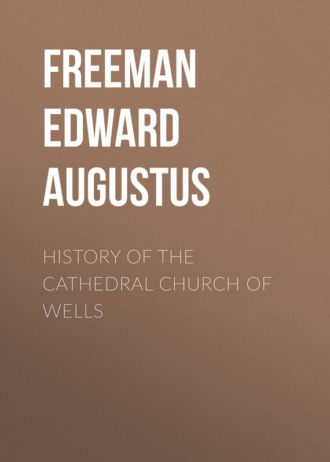 полная версия
полная версияHistory of the Cathedral Church of Wells
These changes, you will see, finished the ground-plan of the church itself as it now stands. The church itself has not been extended northwards, southwards, eastwards, or westwards, since the days of Bishop Ralph. Nor, on the other hand, has any part of the church itself been destroyed. Other buildings have been attached to it, and parts of the subordinate buildings have perished, but the ground covered by the church itself is exactly the same now as it was when Ralph was buried before the high altar. As a church then, as a building set apart for divine worship, Saint Andrew's was now quite perfect and needed neither addition nor change. Nave, choir, presbytery, chapels, and the one necessary adjunct of the Chapter-house, were all finished. But besides the completion of the ground-plan, there was another great work to be done before the building could be said to be finished as a work of architecture. Jocelin had not carried his three towers above the height of the roofs; they were mere stumps, and the effect must have been unfinished and unsightly. In the course of the fourteenth and fifteenth centuries this defect was supplied. Indeed, as far as the central tower is concerned, the defect had been supplied already. I have carried on the history of the changes which affected the ground-plan as a continuous narrative, but the raising of the central tower and its consequences belong to the same period. The raising of the tower seems to have formed part of the general plan of recasting the whole part of the church east of the crossing, and it may actually have been the first instalment of the work. I may here perhaps say a few words on the general subject of central towers. As the principal feature of churches of the highest class, the central tower is all but confined to England and Normandy; in other parts of France it is common enough, but, reversing our English rule, it is common in churches of a smaller class, but nearly unknown in the great cathedrals and abbeys. I ought perhaps to say that I am now speaking mainly of Gothic buildings, not of Romanesque. The truest way of putting the case would perhaps be that the central tower, the direct representative of the cupola, is a Romanesque feature, prevalent everywhere in Romanesque times, but which England and Normandy alone retained in large churches of later date. The question of central tower or no central tower resolves itself into this; which is the greater merit in a cathedral or other great church – the highest amount of internal majesty, or the highest perfection of external outline? England and Normandy decided for the external outline; the rest of Western Christendom decided for the internal effect. A great French church, Amiens, Beauvais, Chartres, Rheims, Saint Quentin, is carried up to a height in the inside of which we in England have no notion. But this internal majesty is bought by the utter sacrifice of external outline. The crossing of the four limbs of the church cries in vain for its natural crown in the central lantern. Indeed I am not clear that, if the central tower is left out, it is not better to leave out the transepts also. Certainly no churches ever impressed me more than those of Bourges and Alby, which follow this arrangement. Some of the great churches of France, which are most glorious within, are absolutely shapeless without. The central tower is impossible, and it is hard to adapt even western towers to a body of so great a height, unless their size is something prodigious. On the other hand, several of our English churches, on whose external outline the eye rests with the greatest pleasure, are positively depressing when we go in. Such above all is Lincoln; nothing can surpass the grouping of its three towers, but the effect of the lowness of the choir roof is positively crushing. The only church in England which affects great internal height is that of Westminster, and there, though a central tower was certainly designed, it seems to have been found impossible to carry it up. The general look of Westminster Abbey is therefore much more that of a French than that of an English church. I know of one church only which thoroughly combines both kinds of merit, namely, the church of Saint Ouen at Rouen. There are French churches of greater height; there are English and Norman churches of more perfect outline. But no other church of equal internal height carries a central tower; no other church finished with a central tower can boast of the same internal height. Inferior to Amiens in one point, to Lincoln in another, I place Saint Ouen's, as a whole, above either.
Turn we now to our own church of Wells, a church, I need not say, built on a much smaller scale than any of those of which I have been speaking. It was of course designed, according to the usual English custom, for a central tower, though most likely Jocelin did not think of carrying it up so high as was afterwards done. This was constantly the case; a tower was carried up to a vast height, in what we cannot help calling a reckless way, on piers and arches which had been designed only for a much smaller weight. The natural consequence followed; the supports began to give way under the vast mass which was laid upon them, and, to keep the whole from falling, some means or other of propping, in a way necessarily more or less awkward, had to be resorted to. In many cases the tower actually fell down, as the spire of Chichester fell a few years ago. That it fell at that particular moment seems to have been pure matter of accident. It had always been dangerous; it might just as well have fallen three or four hundred years sooner, or it might just as well have lasted three or four hundred years longer. So at Salisbury, that lovely spire, so graceful to the sight, is constructively an excrescence which ought never to have been placed there, which the piers below it were never designed to support, and which has been kept up to this day only by using various props and devices from time to time. Our own case at Wells was bad enough, though not nearly so bad as at Chichester and Salisbury. The tower was carried up between the years 1318 and 1321,114 but if any spire was ever added or designed, it was simply one of wood and lead, like those which have vanished from all the three towers of Lincoln. Hence, though the weight which was laid on the piers was much greater than they were able to bear, it was not so great as at Salisbury and Chichester, and the danger and destruction has not been so great as it has been in those two cases. The tower then was raised, and the usual results followed, results which have been graphically described by Professor Willis both at Wells and in other places. The increased height caused the four great piers to sink into the ground. This of course tore away the masonry of the four limbs of the church from their connexion with the piers; the new tower, perhaps as yet hardly brought to perfection, stood, so to speak, on four lame legs, on four supports which were giving way beneath it, and yawning gaps began to appear between the tower arches and the main walls of the church. Thus, within twenty years after its first building, in the years 1337 and 1338,115 the tower needed to be strengthened by supports which the first builders had never thought of, and the damage which had already been actually done had to be made good. The tower at Wells had to be propped like the towers at Canterbury and Salisbury. The question at once follows as to the way in which the propping was done. Any support of the kind must be more or less unsightly; thrust in as an after-thought, to remedy a constructive defect, it cannot fail to interfere with the original design and the original proportions. No one would have put them there, if he could have helped it; if constructive reasons had not called for the props, they would have been better away. When we compare the way in which this needful, though unpleasant, work was done in the different cases, we shall see a kind of clumsy ingenuity about the Wells work which may call for a certain measure of praise. At Salisbury and Canterbury the prop takes the form of a horizontal screen running across the arches. Such a form is more elegant in itself, and it interferes less with the general appearance of the building. But it is more distinctly an excrescence; it forces itself more strongly on the eye as something stuck in than when the props are worked into the earlier work in the way that they are at Wells. You all know the low arches under the lantern with the inverted arches on the top of them, the great circles in the spandrils, the whole arch turned into a kind of pattern of gigantic Geometrical tracery. It is very heavy, very clumsy; till the eye gets thoroughly familiar with it, it seems very ugly; but it is in every way ingenious. The prop is worked and fitted into the old work in a way in which it is not in the other cases. I can even think it possible that people who do not know the history, and who do not at once see from its details that it is an insertion, may even mistake it for part of the original design. And, granting its position at all, granting the peculiar form which it takes, there is something in the detail or rather lack of detail, something in the great size of the few mouldings and the absence of capitals and shafts, which seems to suit the boldness of the general outline. And I am not sure whether there is not a further propriety in the form chosen. The lines of the inverted arches roughly suggest a Saint Andrew's cross, and it may be that we have here, now that the affairs of Wells were beginning to brighten, a new trophy of success offered to the now triumphant elder brother.116
The object of the inverted arches was strictly to support the tower by strengthening its piers. Other changes were needed to make good the damage done by the tearing away of the masonry on each side. This involved a partial blocking of the clerestory and triforium in the bays adjoining the tower, so as to make a set of gigantic flying-buttresses for its support. The pier-arches below them had most likely been quite shattered; those at least in the nave and transept certainly had been. New arches in the style of the fourteenth century were accordingly inserted, and it is instructive at once to compare the difference of their details from those of the original work, and to trace the exact extent of the new masonry. As ever, the mediæval builders wasted nothing; every stone of the old work which could be kept in its place or used again they did keep in its place or use again. And though the details are of exactly the same date and style as those of the inverted arches, it is worth while to notice the extreme boldness with which the mouldings are wrought in the great arches, and the extreme delicacy with which they are wrought in the smaller ones. Altogether it is plain that the raising of the tower must have been done recklessly and without due regard to the strength of its supports. It is plain also that the result of this reckless building has been the lasting disfigurement of the church by the insertion of props which the eye wishes away. Still, as the disfigurement had to be made, we must allow the praise of considerable ingenuity to the way in which it was made.
All that was now lacking to the fabric of the church was the completion of the western towers. The general effect of these towers is so exactly alike that no one would guess that nearly fifty years passed between the building of the two. A minute examination will reveal certain small differences. The height of the two towers is not exactly the same, and a niche which is found on one is not repeated on the other. But these are not differences of style: they are just the same kind of differences as those which we find at an earlier time between the different parts of the nave. Still it is strange to find that a gap of so many years had made absolutely no difference at all in style strictly so called. But this, at this time at least, is characteristic of the district. The Perpendicular style was introduced into Somersetshire very early, and it remained in use for a long time without any material change. Between the earliest and the latest examples there undoubtedly is a difference, but it is a difference much slighter than is usual in other parts of the country. In many cases there is no perceptible difference of style between buildings separated by an interval of a good many years. I have therefore always declined to guess at the dates of Perpendicular buildings in Somersetshire, when no documentary evidence could be brought forward; and I think that the case of the western towers of Wells shows that I have been discreet in so doing. I do not think that any one would have found out the difference in date between these towers by simply looking at them, and I think that any one would have been inclined, from simply looking at them, to place the earlier of the two a good deal later than its real date. I must confess that, knowing as I do that they are nearly fifty years apart, I sometimes find it hard to remember whether it is the northern or the southern tower which is the older. In fact, the southern one is the older. It was built in the time of John Harewell, who was Bishop from 1366 to 1386, at the joint cost of himself and the Chapter, the Chapter paying two-thirds and the Bishop one.117 The tower therefore belongs to the very first days of the Perpendicular style; it must have followed so soon upon the east window of the choir, that we may count the completion of the western towers as really parts of the same work as the changes in the eastern part of the church. The other, the northern tower, was built in the days, and largely at the cost, of Bishop Bubwith,118 whose name is well known to us all by reason of his hospital and his chantry chapel. He has also a special place in the municipal history of the city, through his gift of the old Guildhall to the citizens. His episcopate lasted from 1408 to 1424, so that the very considerable difference of date between the building of the two towers is clearly marked.
Nothing more remains to be spoken of in the fabric of the church itself, beyond a few insertions in the Perpendicular style – such, for instance, as the window tracery inserted in the nave and transept. I do not know the exact date of this not very important change, but it must have been late in the fourteenth or early in the fifteenth century. For it is plain that it was made before the reconstruction of the cloister and the addition of the rooms over it, as these last block one of the windows inserted in the transept. Now these rooms were built by Bishop Bubwith,119 so that the insertion of the tracery was made before his time, not improbably when the southern tower was carried up. A more important change, and one which must have happened later, was the insertion of a fan-tracery vault in the central tower, hiding the original arcades which remain above it. One hardly sees the reason of this insertion, as there could be no reason for hanging bells in the central tower of a church which had two towers at the west end.
Thus, after about two hundred years from the beginning of the present building in the days of Jocelin, we may look on the cathedral church of Saint Andrew as at last finished. It was finished, in a sense, before the end of the thirteenth century, when everything had been built which was needed for its ecclesiastical completeness. But it was in the course of the fifteenth century that it finally assumed the shape with which we are all familiar, and which has from that time remained almost unchanged. Now then we have reached the point at which we can estimate the place which fairly belongs to the church of Wells among the other churches of England and of Christendom. As it seems to me, that position, as I began by saying, is a special and remarkable one. I need not say that, in point of size and splendour, the church of Wells has no claim to a place in the first rank of European, or even of English, churches. Setting aside the Welsh churches, and the churches which have become cathedral without being originally meant for that rank, Wells is one of the very smallest of English episcopal churches. It is hardly fair to compare it with Carlisle, which is a mere fragment, or with Hereford, which has lost its western tower, and with it a part of its nave. But it is, in point of scale, with Carlisle, Hereford, Lichfield, and Rochester, or again with non-cathedral churches like Southwell, Beverley, and Tewkesbury, that Wells must fairly be compared, not with churches like Canterbury and York, or even like Salisbury and Gloucester. And among churches of its own class it certainly ranks very high. It has one accidental advantage in having been much less damaged by mere destroyers than any of them, except perhaps Beverley. But this is not all. I think that those under whose hands the church of Wells gradually grew up showed a wiser discretion, and a greater skill in adapting their changes and additions to what they found existing, than was shown in most of the other cases. Let us take the two ends of the church, the two parts to which a church owes so much of its external character, the east end and the west front. Now the west front of Wells is a thing which it is the fashion to rave about. It is the finest part of the church; the finest thing in Somersetshire; the finest thing in England; for aught I know, the finest thing in the world. I am perverse enough to think differently, and to look on the west front as the one part of the church of Wells which is thoroughly bad in principle. It is doubtless the finest display of sculpture in England; but it is thoroughly bad as a piece of architecture. I am always glad when I get round the corner, and can rest my eye on the massive and simple majesty of the nave and transepts. The west front is bad, because it is a sham – because it is not the real ending of the nave and aisles, but a mere mask, devised in order to gain greater room for the display of statues. The architecture, in short, is sacrificed to the sculpture. A real honest west front, if it have two towers, will be made by the real gable of the nave flanked by a tower at the end of each aisle. So it is at York; so it is at Abbeville; so it is at Llandaff. Or a front may, like those of Winchester, Gloucester, and Bath, have no towers at all, but may simply consist of the endings of the nave and aisles, set off with turrets and pinnacles. Or a front may be, like that one glorious and unequalled front at Peterborough, built up in front of and across the endings of the nave and aisles, but without at all professing to be itself their finish. All these forms are honest; but I deny the honesty of such fronts as those at Wells, Salisbury, and Lincoln.120 In all these cases the front is not the natural finish of the nave and aisles; it is a blank wall built up in a shape which is not the shape which their endings would naturally assume. It is therefore a sham; it is a sin against the first law of architectural design, the law that enrichment should be sought in ornamenting the construction, in giving a pleasing form, and such enrichment as may be thought good, to those features which the construction makes absolutely necessary, not in building up anything simply for the sake of effect. The main features in a front should be the windows and doorways. There must be some windows and some doorways; it is the business of the architect to make these necessary features the main sources of ornament. Now in the Wells front the windows and doorways are made nothing of; they could not be altogether got rid of, but they seem to have been felt as mere interruptions to the lines of sculpture. They are therefore stowed away as they best may be, and they do not form, as they should, the main features of the front. Look, for instance, at Llandaff; the front suffers much from the incongruity of the two towers built at different times: but look at the ending of the nave itself; that perfect composition of lancets, inside and out, is, as it should be, the main feature; at Wells the west window is made nothing of; it is simply cut through the sculpture. The small size of doorways is a common fault of English as opposed to foreign churches; but at Wells they reach the extreme point of insignificance in those narrow mouse-holes at the end of the aisles, through one of which we are commonly driven to creep, while the west doorway remains shut. But even the west doorway itself is a very small mouthful, I will not say after Laon or Rheims, but after York; nay even at Lichfield and Salisbury the doorways have a little more of dignity than they have at Wells. In a really good design the architectural features ought to be the first thing; sculpture or any other source of ornament should be secondary. At Wells the rule is reversed; a sham wall is built up and loaded with statues, and the windows and doorways are left to shift for themselves.
You may perhaps be surprised, perhaps even a little indignant, at the freedom of my criticism on a work which you have doubtless all learned to look on with traditional admiration. But there is nothing like truth, and I think that, if you go and fairly examine for yourselves, you will see that the censures which I have made on our west front rest on good grounds. Those censures are pretty well summed up in the one charge of unreality. But, if we can get over that charge, there is much to be said for the design on the score of boldness and originality. You know that the towers, instead of standing, as usual, at the ends of the aisles, stand beyond them, an arrangement which I have seen nowhere else except in the metropolitan church of Rouen.121 Now in a church of the comparatively small size of Wells the effect of this arrangement is undoubtedly to sacrifice height to width, and thereby to take away from the truest dignity of the front. Still it is not to be denied that even the width has a dignity of its own, and the arrangement was well planned with regard to the special object in view, that of gaining the greatest possible space for the display of sculpture. And after all, though the west front of Wells is a sham, it is by no means so contemptible a sham as the west fronts of either Salisbury or Lincoln. The form given to the front, if unreal, is at least stately. At Salisbury the form given to the front is equally unreal, and it is indescribably mean; as no western towers were intended, one cannot conceive why the natural endings of the nave and aisles were not left, as at Winchester, Gloucester, and Bath, and in our great parish churches of Yatton and Crewkerne. The Wells front again is at least a whole; the Lincoln front is a mass of incongruous pieces. Large parts of two earlier fronts are left to disturb the harmony of the design, and a blank wall is actually carried in front of two of the noblest towers in the world, as if of set purpose to destroy their effect. The Wells front, after all, unreal as it is, has more connexion with the main building than that of Beverley, where a front, poorly imitated from that of York, is built up against the church, with a gable which has no reference whatever to the real gable of the nave.122 At Wells, again the later builders seem to have had more feeling than usual for the harmony of the front. Wells has not suffered like Southwell, where a huge Perpendicular window was cut through the noble Romanesque front, and a sham wall with a flat battlement carried up above it. The towers were carried up in the fourteenth and fifteenth centuries in a way which harmonizes very well with the general design of the front, though there is no kind of adaptation to its details. And here comes the question which I believe everybody asks at a first sight of Wells Cathedral. As I once heard it clearly and tersely put, "Well, that is a fine piece of work, but what are those pieces without their tops?" Every one, I suppose, feels the unfinished look of the towers; the eye craves for something or other more than there is, be it pinnacles, spires, or anything else. Now I once very carefully examined the tops of the towers in company with Mr. Parker, and we could see no signs that there ever had been, or had been designed to be, any stone-work more than there is now. But any sort of finish that any one chooses to imagine may have been added, or designed to be added, in wood. I suspect that people seldom take in how many of our great churches had their towers finished with spires of wood covered with lead or shingle. Spires of this sort were either destroyed by accident or taken away in wantonness at Old Saint Paul's, Lincoln, Ely, Hereford, Exeter, Southwell, and a crowd of other churches. A single one of two still remains at Ottery Saint Mary. On the Continent they are far more common, and they sometimes furnish beautiful examples of work in lead. Among the English examples, the towers of Lincoln supply the example which is most instructive for our own case. The spires are gone, but the angle turrets are still finished with pinnacles of wood covered with lead. Whether such an arrangement as this ever actually existed at Wells I do not know, but there can be no doubt that a finish of this kind, spires of wood sheeted with lead, with pinnacles of the same materials at the angles, would be the true means of getting rid of the flat and imperfect look of which every one complains.







